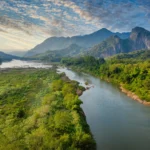
The Danube River, Europe’s second-longest river, flows through an incredible array of landscapes, cultures, and histories. Spanning over 2,850 kilometers, this majestic waterway weaves its way through ten countries, from its source in the Black Forest of Germany to its mouth at the Black Sea. The Danube is not just a geographical feature; it is a vital artery of life that supports diverse ecosystems, rich agricultural lands, and vibrant communities. In this blog post, we will explore 25 fascinating facts about the Danube River, uncovering its ecological significance, cultural heritage, and historical importance. Whether you’re a nature enthusiast, a history buff, or simply curious about one of Europe’s most iconic rivers, there’s something here for everyone to discover!
Length: The Danube River is the second-longest river in Europe, measuring approximately 2,860 kilometers (1,780 miles). It flows through a diverse range of landscapes, from the mountainous regions of Germany to the flat plains of Eastern Europe. Its length makes it a vital waterway for many countries, facilitating trade, transportation, and tourism. The river’s extensive reach connects various cultures and economies, making it a significant geographical feature in Europe.
Countries: The Danube flows through ten countries: Germany, Austria, Slovakia, Hungary, Croatia, Serbia, Romania, Bulgaria, Moldova, and Ukraine. This unique characteristic makes the Danube one of the most international rivers in the world. Each country contributes to the river’s cultural and historical tapestry, showcasing a blend of traditions, languages, and customs. The river serves as a natural border and a bridge between nations, fostering cooperation and dialogue among the countries it traverses.
Origin: The Danube originates in the Black Forest of Germany, specifically at the confluence of the Brigach and Breg rivers. This area is known for its picturesque landscapes, dense forests, and biodiversity. The source of the Danube is significant not only for its geographical importance but also for its cultural heritage, as the region has been inhabited for thousands of years. The river begins its journey as a small stream and gradually grows wider and more powerful as it collects water from numerous tributaries along its course.
Delta: The Danube flows into the Black Sea through the Danube Delta, located in Romania and Ukraine. This delta is one of the largest and best-preserved in Europe, covering an area of about 5,165 square kilometers (2,000 square miles). The delta is recognized for its rich biodiversity, hosting over 300 species of birds and numerous fish species. It is a UNESCO World Heritage Site and a biosphere reserve, highlighting its ecological significance. The delta’s intricate network of channels, lakes, and wetlands makes it a vital habitat for wildlife and an important area for scientific research.
Drainage Basin: The Danube has a drainage basin that covers approximately 801,463 square kilometers (309,000 square miles), which is about 10% of the total area of Europe. This vast basin collects water from numerous tributaries, including the Inn, Morava, and Sava rivers, and supports a diverse range of ecosystems. The basin is crucial for agriculture, industry, and urban development in the region. It also plays a significant role in flood management and water quality, as it is interconnected with various rivers and lakes that feed into the Danube.
Capital Cities: The Danube passes through four capital cities: Vienna (Austria), Bratislava (Slovakia), Budapest (Hungary), and Belgrade (Serbia). Each city has developed along the river, leveraging its resources for trade and transportation. The Danube has shaped the cultural and economic landscapes of these capitals, making it a central feature in their histories. The riverbanks are often lined with historic buildings, parks, and promenades, providing residents and tourists with scenic views and recreational opportunities.
Biodiversity: The Danube is home to over 5,000 species of plants and animals, including the endangered Danube sturgeon, which is one of the oldest fish species in the world. The river’s diverse habitats, such as wetlands, forests, and riverbanks, support a rich array of wildlife. Conservation efforts are essential to protect these species and their habitats, especially as the river faces challenges from pollution and habitat loss. The Danube’s biodiversity is not only important for ecological balance but also for maintaining the cultural heritage of the regions it flows through.
UNESCO World Heritage Site: The Danube Delta is recognized as a UNESCO World Heritage Site due to its exceptional natural beauty and biodiversity. It is one of the largest and best-preserved deltas in Europe, featuring a complex system of waterways, marshes, and islands. The delta is a critical habitat for many species, including migratory birds, fish, and unique plant life. Its ecological significance and cultural heritage make it a focal point for conservation efforts and sustainable tourism, attracting researchers and nature enthusiasts alike.
Navigability: The Danube is navigable for about 2,400 kilometers (1,500 miles), making it an important waterway for trade and transport. Various ports and harbors along the river facilitate the movement of goods and people, contributing to the economies of the countries it flows through. The river’s navigability has historically made it a key trade route, linking inland regions to the Black Sea and beyond. Modern infrastructure, including locks and dams, has enhanced its navigational capacity, allowing larger vessels to navigate its waters while managing water levels for flood control and irrigation.
Cultural and Historical Significance: The Danube has been a significant cultural and historical site, influencing the development of many civilizations along its banks. Throughout history, it has served as a vital trade route for merchants and armies, shaping the economies and politics of the regions it traverses. The river has witnessed the rise and fall of empires, including the Roman Empire, which utilized the Danube as a frontier. Many cities along its banks are steeped in history, with ancient ruins, castles, and monuments that reflect the diverse cultures that have thrived there. The Danube continues to inspire artists, writers, and musicians, making it a lasting symbol of European heritage and identity.
Picturesque Landscapes: The Danube is renowned for its breathtaking landscapes, particularly in regions like the Wachau Valley in Austria. This UNESCO World Heritage site is characterized by rolling hills, terraced vineyards, and charming villages, making it a popular destination for tourists and locals alike. The valley is dotted with historic castles and monasteries, such as the Melk Abbey, which overlooks the river. The scenic beauty of the Danube attracts photographers, artists, and nature lovers, providing opportunities for hiking, cycling, and river cruises that showcase the stunning vistas along its banks.
Hydroelectric Power: The Danube is a significant source of hydroelectric power, with several dams and power plants situated along its course, such as the Iron Gate Dam on the border between Romania and Serbia. These facilities harness the river’s flow to generate electricity, contributing to the energy needs of the surrounding regions. Hydroelectric power is considered a renewable energy source, and the Danube’s capacity for energy generation plays a crucial role in supporting local economies and reducing reliance on fossil fuels. However, the construction of dams also raises environmental concerns, necessitating careful management to balance energy production with ecological preservation.
“Blue Danube”: The river is often referred to as the “Blue Danube,” a name popularized by Johann Strauss II’s famous waltz composed in 1867. The waltz has become an iconic piece of classical music, frequently associated with the river and its cultural significance. The term “Blue Danube” evokes images of the river’s serene beauty and romantic charm, inspiring countless artistic representations. The waltz is often performed at concerts and events, celebrating the river’s influence on music and dance. The Danube’s association with the waltz highlights its role in shaping the cultural identity of the regions it flows through.
Drinking Water Source: The Danube is a vital source of drinking water for millions of people living in its basin. Major cities, including Vienna and Budapest, rely on the river and its tributaries for their water supply. The river’s water quality is monitored closely to ensure it meets safety standards for consumption. Efforts to reduce pollution and improve water quality are essential for maintaining this critical resource. The Danube’s role as a drinking water source underscores the importance of sustainable management practices to protect its ecosystem and the health of communities that depend on it.
Flood Management: The flow of the Danube is regulated by several dams and reservoirs designed to control flooding and provide water for irrigation. These structures help manage the river’s water levels, especially during heavy rainfall or snowmelt, reducing the risk of flooding in adjacent communities. Flood management is crucial in protecting agricultural lands, urban areas, and infrastructure along the river. While dams provide benefits, they also pose challenges, such as altering natural habitats and affecting fish migration. Balancing flood control with ecological considerations is a key aspect of river management in the Danube basin.
Historical Trade Route: The Danube has served as a significant trade route since Roman times, facilitating the movement of goods and people across Europe. Its navigable waters allowed for the transport of various commodities, including grains, timber, and metals, contributing to the economic development of the regions along its banks. The river’s strategic importance has made it a focal point for trade and commerce throughout history, influencing the rise of cities and trade hubs. Today, the Danube continues to play a vital role in regional trade, with modern shipping routes and ports supporting economic activities in the countries it traverses.
Cruise Destination: The Danube is a popular destination for cruise ships, attracting tourists from around the world. River cruises offer a unique way to explore the scenic beauty and cultural heritage of the Danube, with itineraries that often include stops at historic cities, vineyards, and cultural landmarks. Passengers can enjoy onboard amenities while taking in the picturesque views of the river and its surroundings. The cruise industry has grown significantly in recent years, providing an economic boost to local communities and promoting sustainable tourism practices along the river.
Archaeological Sites: The Danube is home to several important archaeological sites, including the Roman city of Carnuntum in Austria, which was a significant urban center during the Roman Empire. Excavations have revealed well-preserved ruins, including amphitheaters, temples, and residential buildings, providing insights into ancient Roman life. Other archaeological sites along the river showcase the rich history of human settlement and cultural exchange in the region. These sites are valuable for researchers and historians, contributing to our understanding of the past and attracting visitors interested in history and archaeology.
Diverse Ecosystems: The Danube River is renowned for its rich and diverse ecosystems, which include wetlands, forests, and floodplains. These habitats are home to a myriad of species, including fish, amphibians, and various plant life. The wetlands, in particular, serve as crucial breeding grounds for many aquatic species and provide essential ecosystem services such as flood control and water purification. The forests along the riverbanks contribute to biodiversity and serve as important corridors for wildlife movement, making the Danube a vital ecological resource in Europe.
Improved Water Quality: Over recent decades, the water quality of the Danube has seen significant improvements, largely due to international cooperation and stringent environmental regulations. Initiatives such as the Danube River Protection Convention have fostered collaboration among the countries that share its waters, leading to better management practices and pollution control measures. This collaborative effort has resulted in the reduction of industrial discharges and agricultural runoff, leading to healthier aquatic ecosystems and enhanced water quality that supports both biodiversity and human activities.
Habitat for Migratory Birds: The Danube River serves as a crucial habitat for migratory birds, making it a key area for birdwatching enthusiasts. It provides essential stopover points for various species during their migration routes, particularly in the Danube Delta, which is a UNESCO World Heritage site. The delta’s rich biodiversity supports numerous bird species, including herons, pelicans, and storks. Birdwatching along the Danube attracts nature lovers and contributes to local ecotourism, highlighting the river’s importance as a sanctuary for avian life.
Cultural Significance in Art and Literature: The Danube has inspired countless works of art and literature throughout history, celebrated by poets, painters, and musicians alike. Famous composers such as Johann Strauss II have immortalized the river in their compositions, with the “Blue Danube” waltz being one of the most recognized pieces. The river’s picturesque landscapes and historical significance have made it a popular subject for artists, while writers have drawn on its beauty and cultural importance to convey deeper themes of connection, nostalgia, and the passage of time.
Agricultural Activities: The Danube River basin supports a wide range of agricultural activities, which include vineyards, fruit orchards, and grain production. The fertile soils and favorable climate conditions along the river contribute to a thriving agricultural sector that plays a crucial role in the economies of the surrounding countries. The region is particularly known for its wine production, with several wine-growing areas that produce high-quality wines. This agricultural diversity not only sustains local communities but also contributes to the cultural heritage and culinary traditions of the Danube region.
Historical Events: The Danube has been the site of numerous historical events that have shaped European history, including battles, treaties, and trade routes. Its strategic location made it a vital waterway for trade and transportation, influencing the development of cities and civilizations along its banks. Historical events such as the Treaty of Trianon and various military confrontations have taken place in its vicinity, making the river a silent witness to the continent’s tumultuous past. The rich history associated with the Danube adds to its cultural significance and provides a wealth of stories that continue to be explored and commemorated.
Cultural Festivals and Events: The Danube is a focal point for various cultural festivals and events that celebrate its heritage and the communities along its banks. These events often showcase local traditions, music, dance, and cuisine, bringing together residents and visitors alike. Festivals such as the Danube Carnival and various river regattas highlight the river’s importance as a cultural and social hub. Such gatherings foster community spirit and promote awareness of the river’s historical and ecological significance, ensuring that the Danube remains a vibrant part of the cultural landscape in Europe.
Danube River FAQs
1. What is the Danube River?
- The Danube River is the second-longest river in Europe, flowing for approximately 1,770 miles (2,850 kilometers) from its source in the Black Forest mountains of Germany to its delta in the Black Sea.
- It’s a significant waterway, historically and economically, connecting ten countries: Germany, Austria, Slovakia, Hungary, Croatia, Serbia, Bulgaria, Romania, Moldova, and Ukraine.
2. Where does the Danube River begin and end?
- Begins: In Donaueschingen, Germany, in the Black Forest region.
- Ends: In the Danube Delta of Romania, where it empties into the Black Sea.
3. Which countries does the Danube River flow through?
The Danube River flows through ten countries:
- Germany
- Austria
- Slovakia
- Hungary
- Croatia
- Serbia
- Bulgaria
- Romania
- Moldova
- Ukraine
4. What is the significance of the Danube River?
- Historical Importance:
- Trade Route: For centuries, the Danube has been a vital trade route, connecting Central and Eastern Europe.
- Roman Empire: The Romans played a crucial role in developing the river for transportation.
- Cultural Exchange: The river has facilitated cultural exchange and the movement of people throughout history.
- Economic Importance:
- Shipping: It remains an important waterway for shipping goods, including agricultural products, industrial materials, and even oil.
- Hydropower: Many hydroelectric dams along the river generate electricity.
- Tourism: River cruises are a popular tourist activity, offering stunning scenery and visits to historic cities.
- Environmental Significance:
- Biodiversity: The Danube River supports a diverse ecosystem, including numerous fish species, birds, and other wildlife.
- Challenges: The river faces environmental challenges, such as pollution and the impact of dams on the natural flow.
5. What are some major cities located along the Danube River?
- Vienna, Austria: A world-renowned cultural and historical center.
- Budapest, Hungary: Known for its thermal baths, stunning architecture, and vibrant nightlife.
- Bratislava, Slovakia: The capital of Slovakia, offering a charming historic center.
- Belgrade, Serbia: A city with a rich history and a blend of modern and traditional influences.
- Regensburg, Germany: A well-preserved medieval city with a beautiful Old Town.
6. What are some popular activities on or near the Danube River?
- River Cruises: Enjoying a scenic cruise along the Danube is a popular way to experience the river’s beauty and visit various cities.
- Sightseeing: Exploring the historic cities and towns located along the riverbanks.
- Hiking and Cycling: Many trails and cycling paths follow the river, offering opportunities for outdoor recreation.
- Birdwatching: The Danube Delta is a renowned birdwatching destination.
- Fishing: The river offers opportunities for fishing, though regulations vary by country.
7. What are some of the environmental challenges facing the Danube River?
- Pollution: Industrial waste, agricultural runoff, and untreated sewage can pollute the river.
- Dams: Dams can disrupt the natural flow of the river, affecting fish migration and the overall ecosystem.
- Overfishing: Overfishing can deplete fish populations.
- Shipping Traffic: Heavy shipping traffic can cause erosion and disturb the riverbed.
- Climate Change: Climate change can impact water levels and increase the frequency of droughts or floods.
8. What is being done to protect the Danube River?
- International Cooperation: Several international agreements and organizations are working to protect the Danube River and its ecosystem.
- Water Quality Monitoring: Regular monitoring of water quality helps identify and address pollution issues.
- Habitat Restoration: Efforts are underway to restore and protect important habitats along the river, such as wetlands.
- Sustainable Tourism: Promoting sustainable tourism practices can minimize the environmental impact of tourism activities.
9. What is the Danube Delta?
- The Danube Delta is a vast wetland area where the Danube River flows into the Black Sea.
- It’s one of the largest and most diverse river deltas in Europe, known for its rich biodiversity, including numerous bird species.
- The Danube Delta is a UNESCO World Heritage Site.
10. How can I plan a trip to see the Danube River?
- Choose your starting point: Decide which city or region you’d like to start your journey.
- Select your travel style: Consider a river cruise, independent travel, or a combination of both.
- Research transportation options: Explore options for flights, trains, and buses to reach your starting point and travel between cities.
- Book accommodations: Choose hotels, guesthouses, or other accommodations that suit your budget and preferences.
- Plan your itinerary: Research the attractions you’d like to visit in each city and plan your itinerary accordingly.
- Consider the best time to travel: Spring and autumn are generally considered the most pleasant times to visit the Danube region.
I hope this comprehensive information helps you plan your Danube River adventure!









